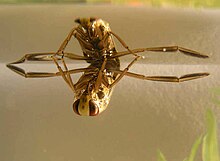Common back swimmer
| Common back swimmer | ||||||||||||
|---|---|---|---|---|---|---|---|---|---|---|---|---|

Common backstroke ( Notonecta glauca ) |
||||||||||||
| Systematics | ||||||||||||
|
||||||||||||
| Scientific name | ||||||||||||
| Notonecta glauca | ||||||||||||
| Linnaeus , 1758 |
The common back swimmer ( Notonecta glauca ) is a water bug (Nepomorpha) from the family of back swimmers (Notonectidae). The special characteristic of this species, as well as the other representatives of the back swimmer, is that they always swim with the stomach side up. This noticeable swimming position results from the air supply carried along on the abdomen on the abdomen.
features
The bugs reach body lengths between 13.5 and 16 millimeters. The ventral side is flat. The back is arched boat-shaped and the wings are roof-shaped. The tag (scutellum) of the animals is colored black, its side edge is longer than the Clavusnaht. The tips of the membrane are about the same length. The front corners of the pronotum (pronotum) are blunt and rounded. Its rear edge is straight. The half-blankets (hemielytres) are colored yellow-gray, yellow-white, yellow-red or green-white and often spotted black or brown. The back of the abdomen is monochrome black or brown - in contrast to the similar Notonecta maculata , which each have a yellow-red cross band on the abdomen in front and behind. The back legs are characterized by webbed hairs that fan out automatically when you swim. The insects swim in a supine position, as most of the air they breathe is held on the underside of the abdomen in two air ducts, each with thick rows of hair.
Occurrence
The species occurs throughout Europe , east to east Siberia and across Central Asia to China . It occurs in the Alps up to around 1,800 meters above sea level, is the most common species of its genus in Central Europe and is common everywhere. Common back swimmers live in almost all stagnant and slow-flowing waters and also colonize highly eutrophic waters. They are less common in acidic moorland and brackish water .
Way of life
The adults , like all other species in their families, feed predatory on small animals that live in the water or that have fallen into the water, such as insects and tadpoles, and are good swimmers. The species develops in one generation per year and overwinters as an imago. Mating usually takes place after wintering, but can also take place in autumn. The females pierce their approximately 200 eggs between February and April with their short ovipositor into plant material. The parent generation dies by May, the adults of the new generation are fully developed after five moults from late July and early August. Especially in autumn you can often see back swimmers flying. Since they are good fliers, they cover great distances and can easily colonize new waters.
Web links
literature
- Ekkehard Wachmann , Albert Melber, Jürgen Deckert: Bugs Volume 1: Dipsocoromorpha, Nepomorpha, Gerromorpha, Leptopodomorpha, Cimicomorpha (Part 1) with Tingidae, Anthocoridae, Cimicidae and Reduviidae . - Goecke & Evers, Keltern 2006, ISBN 3-931-37449-1
- E. Wagner: Heteroptera Hemiptera. - In: Brohmer, P., P. Ehrmann & G. Ulmer (eds.): Die Tierwelt Mitteleuropas. IV, 3 (Xa). - Leipzig 1959, 173 pp.
- Ekkehard Wachmann: Bugs - get to know, observe. Neumann-Neudamm 1989, ISBN 3-7888-0554-4
